The Art of Burning Man
1999, The Art of Burning Man
Burning Man will be burnt again this weekend. Twelve years ago I wrote a piece about the art found at Burning Man that ran in the little-known Whole Earth Review. It still makes sense today.
UPDATE: The live webcam stream from the Burning Man playa is surprisingly compelling. (Thanks Howard!) See it here: http://www.ustream.tv/burningman?rmalang=en_US
[All pictures by me from the 1990s.]
*******
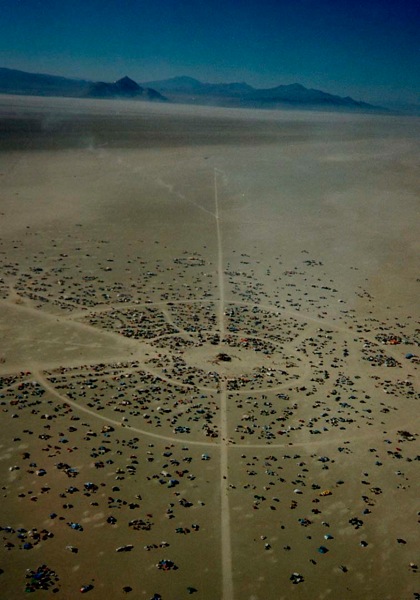
Ariel view of Burning Man, 1996.
Whatever Burning Man is, it is getting bigger. Last summer over 23,000 people hauled their bodies to the empty Nevada desert and make an instant city. Last year it was 14,000, and the year before 8,000. Next year?
Like cyberspace, the more people that build, the better it is. Black Rock City, as the town centered around Burning Man is known, is now the third largest city in Nevada, although it exists for only one week a year. It is also perhaps one of the best-designed cities in the world. It works wonderfully. It’s safe enough for women to walk around naked. It’s chock full of fantastic and real art. Transportation is primarily via bicycle. It’s got a world class view of a unique wilderness. Consumption is low, and creation is high.
My own fascination with Burning Man comes from the incredibly varied and authentic art produced each year, and the distinct way it fills the heart of this the instant town. The art ranges from hundreds of homemade banners flown in camps, to wild nomadic architectural experiments, to personal creative statements erected along the road, to spontaneous theater, to gigantic and intricate installations that must take a year to create. Several qualities make the art of Burning Man some of the best art being made these days.
First, it is art situated in a real place. Most of the pieces, including the folk art, are birthed out of the particular climate and geography of the alkaline flat. It’s environmental art, place art. The makings play off the emptiness, or the drabness, or the flatness of this particular place. Or they play off the absence of urban lights at night. They use the infinity of the clay playa itself to create something. Concepts that would not work in a room can shine in this stark world of wind and dust.
Secondly, the art is ubiquitous but not precious. Burning Man’s city is so vast now that it is way beyond the capabilities of a single person to see. You could walk days and not see every creation, every bit of impromptu theater, every bizarre juxtaposition (I’ve tried), but nor are you supposed to. Some of the best pieces are built a long ways from the bustle; if you happen to walk out there and see it, great! There are no signs directing you there, no ads, no touting, no map, no tour, no desperate attempts to make sure you visit. The art is generous in that way. It doesn’t even demand that you see it. More often than not it was made for the pleasure of making it. If you happen upon it and enjoy it, all the better.
Thirdly, all the art is anonymous. There are no tags and labels, even for the best, most time-intensive creations. The most ambitious pieces take months to prepare, and thousands of dollars to create. Some might be made by well-known artists (and some are) and some by complete unknowns (and most are), but no distinction is even attempted. Without the striving that names bring the art is easier to enjoy. The anonymity also nudges others to try making something – an object, a place, or an event. As the official Burning Man mandate goes — “No Spectators.” The audience become artists (at least for a week) and the artists become the audience.
Lastly, there is no money inside. Perhaps the most radical design of Burning Man has been its nearly total prohibition of commerce within the city. This is not done out of any heavy socialistic impulse: after all tickets at the gate cost $100. Rather it was a brilliant move to institute a zone of creation where the focus was on passion, expression, and gifts. For instance it is perfectly acceptable to give away lemonade and snow cones, or cook free pancakes for all comers, and this is what indeed happens. The art is given away, which better than money, encourages others to make stuff to give away. To an extant I would not have believed possible the banning of vending of any type, of advertising, of buying and selling (at least in the city itself) transformed the art of the city. The necessary survival self-reliance this entails (you got to bring everything you need to live since you can’t buy anything) also births an artistic self-reliance.
How big can Burning Man get and still retain this wonderful sensibility? Few would have doubted it could have grown to the size a typical American town and still work in this exuberant way, but its founder, artist Larry Harvey, believes Burning Man could encompass 100,000 inhabitants or more and still work as a city of art. And that’s what he is planning to do. I’m beginning to believe that it is possible. If you’d like to join (no spectators!) start with burningman.com.
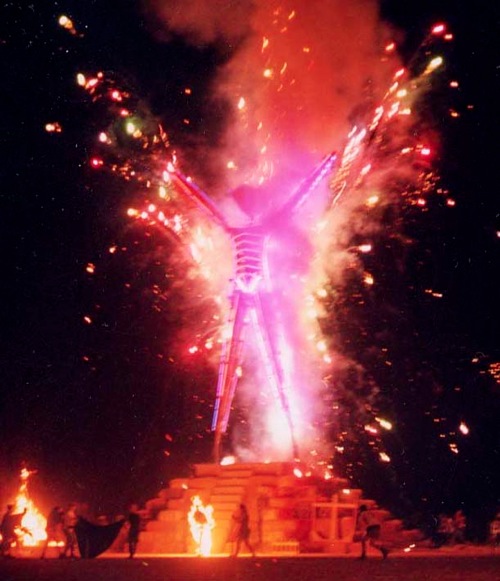
Two Burning Men — Burning Man is lit by an asbestos-covered burning human, who runs up to the leg of the wooden man lights the fuse with his burning arm, and runs down again (the flame in the center of the picture. Fireman run with blankets to cover the burning man while the Burning Man erupts in flame and fireworks.
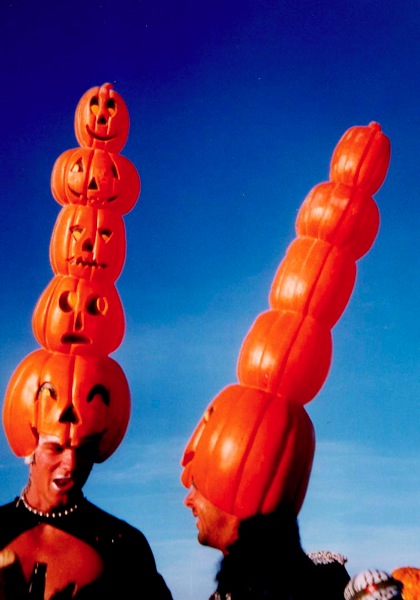
Pumpkin heads – On the eve of day before the Burning of the Man there is a costume party and fashion show, and the assignment seems to be to outdo everyone is sheer exuberance. If you’ve got something, flaunt it. The more alien, unearthly, and over-the-top, the better.
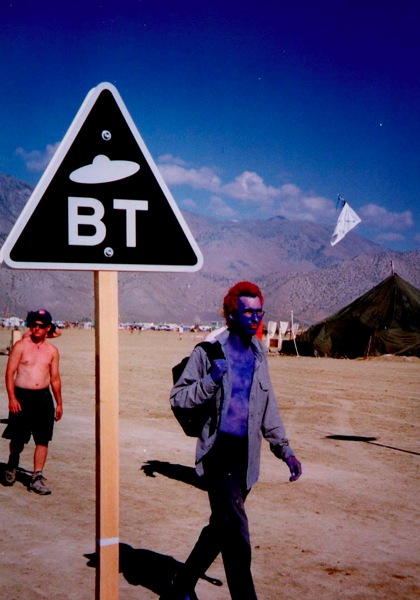
BT sign – In 1998 mysterious signs appeared throughout the city along the emergent roads and at intersections. This one was clearly warning of BTs ahead.
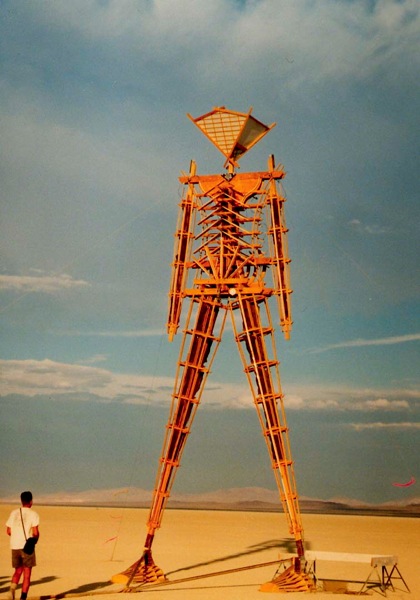 The Man – The great genius of the Burning Man itself is that the figurine is exactly the same size and structure every year. While the rest of the encampment morphs day to day, year to year, trying to outside in bizarre creativeness, the Man remains creatively constant. Before the burn, it invites anyone to its altar for inspection or dancing.
The Man – The great genius of the Burning Man itself is that the figurine is exactly the same size and structure every year. While the rest of the encampment morphs day to day, year to year, trying to outside in bizarre creativeness, the Man remains creatively constant. Before the burn, it invites anyone to its altar for inspection or dancing.
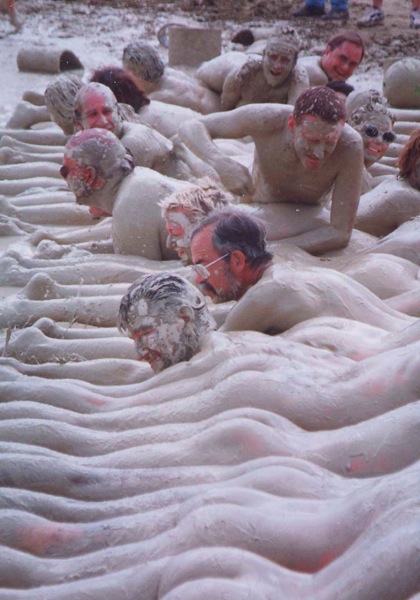
Butts — The alkaline playa turns to the stickiest possible mud with the application of a little water. Many attendees make clay sculptures on the spot; others wallow in the gooey ooze. Some thoughtful person imported a truckload of water and made a mud pool. The game was to slither over the rumps of others and at the end of the line become a rump yourself.
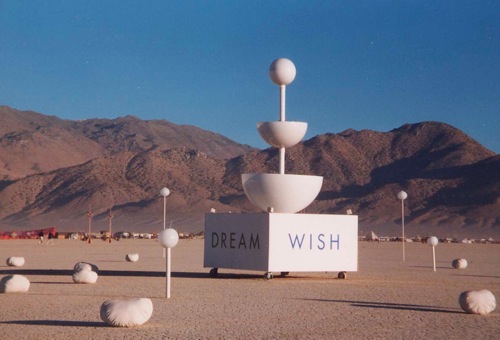 Dream – During the day this structure emitted a constant broadcast of millions of tiny bubbles, carried aloft by the ceaseless wind for miles around. During the night, it glowed soft and warm like a low fire and emitted soothing platitudes of hope and optimism in a whisper.
Dream – During the day this structure emitted a constant broadcast of millions of tiny bubbles, carried aloft by the ceaseless wind for miles around. During the night, it glowed soft and warm like a low fire and emitted soothing platitudes of hope and optimism in a whisper.
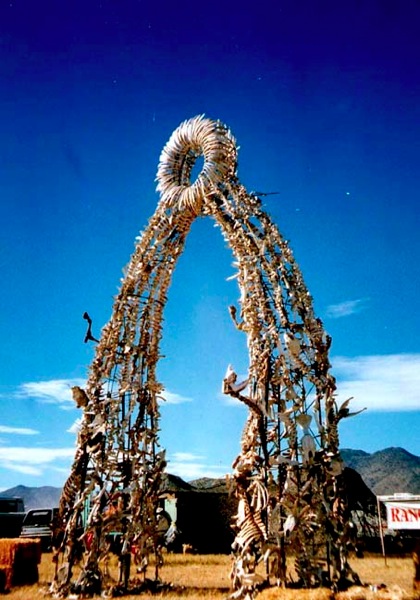
Bone Arch – Hundreds of bleached animal skeletons and skulls (most cows) were wired together into a gothic arch near the center circle of the city.
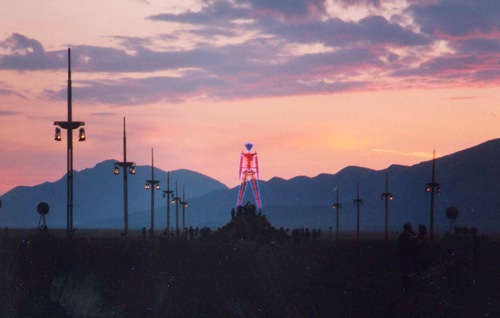
Burning Man at dawn – Just before rosy-fingered Dawn overtakes the starry night, hundreds of attendees gather at the feet of the neon-lit Burning Man for a daily sunrise ritual. There is a collective shout, heard half-mile away, when the first rays of Sun reach the Man.
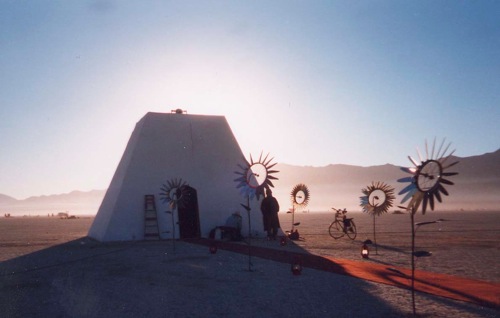
Trapezoid – Inside this lopped-off pyramid is a camera obscura. The interior loft is jet-black dark, with a rotating lens hanging from the roof and shining down on a while circular table. Swing the lens around 360 degrees and you see on the table a living panoramic image of the camp.
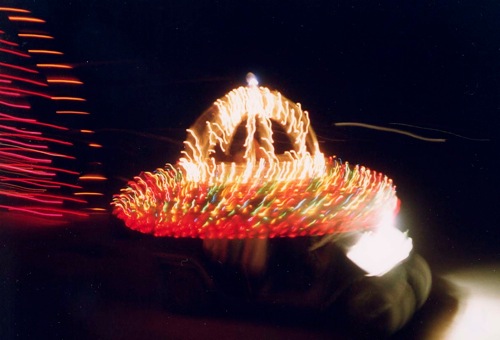
Lighted saucer – The main event at Burning Man is the night. With empty blackness miles from the electric grid, messing with lights has great effects. There are neon hopping kangaroos, neon-galloping horses, neon flying fish on bicycles, green lasers, fiber optic cloaks, glow-line costumes, and a Christmas-lighted saucer like this one.
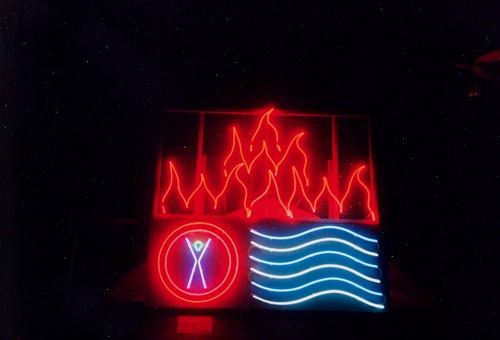
Neon sign – The neon logo of the official Burning Man post office. You can buy official Burning Man stamps to mail letters with the camp.

Painted Hut – Burning Man has evolved its own graphic folk style: clean, bold, full of bright colors, optimism, mechanical rather than organic and deeply alien.
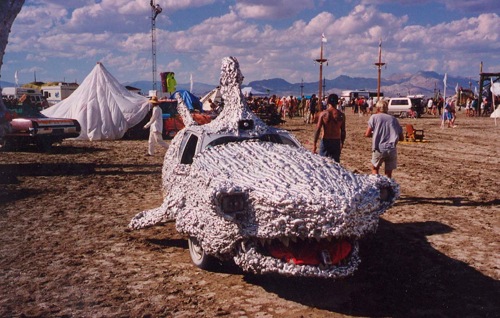
Shark Car – The Burning Man weekend doubles as an art car rendezvous. This one is a classic art-car of painted foam. It cruises the desert slowly.
Bike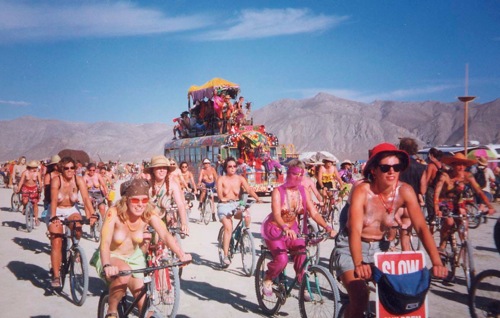 Girls — Tits on Bikes, they call it. It’s a girl thing. The ladies take off their tops, encourage other girls to do the same, and then parade in a great circle around Burning Man while whooping it up big time.
Girls — Tits on Bikes, they call it. It’s a girl thing. The ladies take off their tops, encourage other girls to do the same, and then parade in a great circle around Burning Man while whooping it up big time.
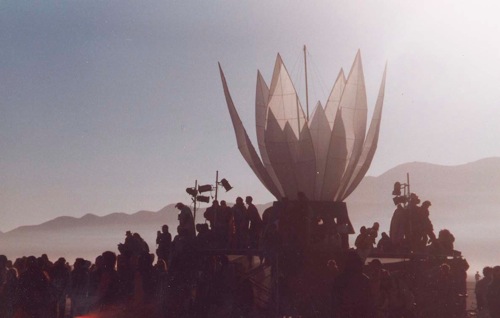
Sail Flower Thing – I have no idea what this thing is supposed to be. It was in the middle of a pile of sound equipment at a rave station. The rave music is extremely loud (you can hear it at least five miles away in the desert) and plays all night long, and turns off promptly at sunrise in the morning.
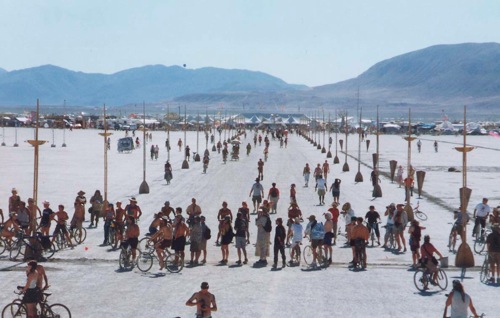
Street – The main boulevard from the central camp to the Burning Man platform. Cars are banned from driving within the city limits so the city of 23,000 residents has become one of the largest pedestrians and bicycle cities alive.

Lanterns – Every evening at dusk, volunteer “fire people” put on their robes, perform a fire-lighting ceremony, and then carry a yoke of kerosene lanterns to place on lamp stands along the radiating streets.
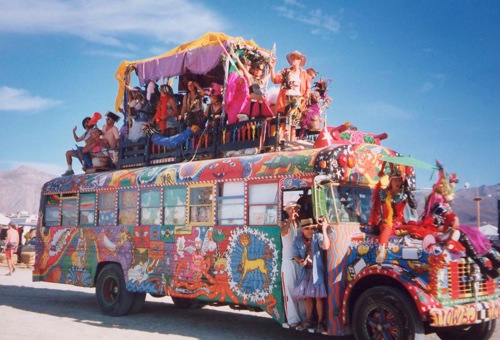
Magic Bus – This painted school bus puts Ken Kesey’s old hippy bus “Further” to shame. It’s got more colors, more weirdness, more levels, more people hanging on, and in every way looks like more fun.


